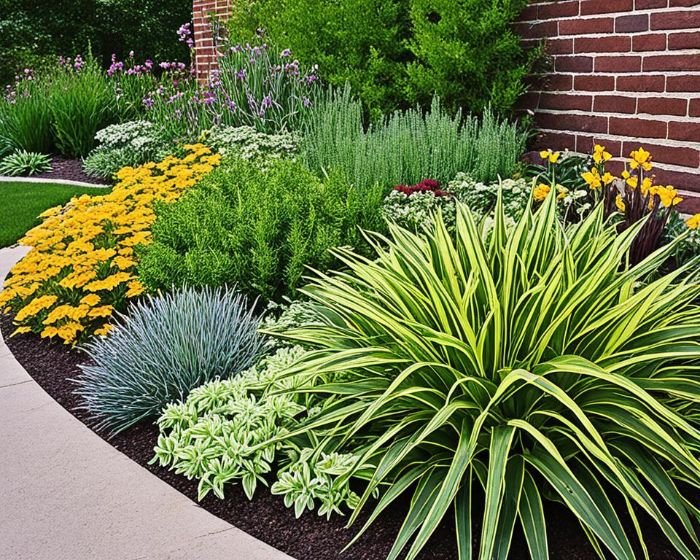A time-efficient garden starts with plants that fit your conditions. Match species to USDA hardiness zone, measured sun hours, and soil drainage. Prioritize traits that reduce routine work, including drought tolerance, disease resistance, steady form, and slow growth rate. Add mulch, set drip irrigation for deep infrequent watering, and use resistant or regionally adapted selections. This combination cuts pruning, watering, and pest control while keeping beds attractive through the season.
Key Takeaways:
- Map sun exposure in hours per day and choose plants labeled for full sun at 6 or more hours, part shade at 3 to 5 hours, or shade at under 3 hours.
- Filter choices by USDA zone and drainage first, then match to soil type such as clay, loam, or sand.
- Favor slow‑growing, clumping forms and evergreen structure to reduce pruning and re‑shaping.
- Set low-care watering with 2-3 inches (5-7 cm) of mulch and drip lines that deliver one or two deep soakings per week during hot months.
- Select pest- and disease-resistant cultivars and native or regionally adapted species to limit chemical inputs and save time.
Table of Contents
Building a Garden That Practically Tends Itself
A self-sustaining garden begins with plant choices matched to the site’s natural conditions. By aligning species with the available sunlight, soil texture, and climate patterns, maintenance work drops dramatically. Instead of adjusting the environment to suit the plants, the strategy is to select plants that already perform well under those conditions. That shift eliminates unnecessary watering, reduces the need for chemical pest control, and limits replanting caused by poor survival rates.
Selecting Species for Local Climate Zones
Hardiness zone data from the USDA Plant Hardiness Map is the most reliable baseline for plant survival expectations in the United States. A plant grown outside its zone often requires intensive care to withstand temperature extremes. Gardeners in colder regions benefit from hardy perennials such as peonies or coneflowers, which tolerate frost and return reliably each year. In hotter, arid zones, drought-adapted plants like agastache or penstemon minimize irrigation needs while maintaining strong flowering displays. Choosing within the recommended zone range ensures that plants endure seasonal shifts without additional protection.
Matching Sunlight Exposure with Plant Requirements
Accurate measurement of sun hours prevents both underperformance and plant stress. Full-sun plants require at least six hours of direct sunlight, while part-shade plants thrive with three to five hours. Shade-tolerant species often prefer dappled light rather than complete darkness, making them well suited for planting beneath deciduous trees. Misaligned placement leads to weak growth, susceptibility to disease, and reduced flowering. A one-week observation of sunlight patterns in each planting area is an effective method for ensuring precise placement.
Using Soil Type to Guide Plant Selection
Soil composition directly affects water retention, aeration, and nutrient availability. Clay soils hold moisture but can suffocate roots if drainage is poor, making them suitable for moisture-loving plants like astilbe. Sandy soils drain quickly, favoring species such as lavender or yarrow that prefer drier conditions. Loam, the ideal blend of sand, silt, and clay, supports a wide range of plants with minimal intervention. Soil testing for pH and organic matter content provides clear data for selecting plants that will thrive without repeated amendments.
Prioritizing Low-Growth and Disease-Resistant Varieties
Slow-growing plants and naturally disease-resistant varieties reduce the frequency of pruning and the likelihood of costly interventions. For example, dwarf conifers maintain structure without shaping, and disease-resistant rose cultivars prevent the need for repeated fungicide treatments. Extension services and reputable nurseries often publish updated lists of proven low-care cultivars suited to regional challenges, making them valuable resources for plant selection.
A garden aligned with its natural setting develops into a balanced ecosystem that demands less from the gardener over time. Each plant thrives because the environment already supports its needs, allowing maintenance to shift from constant adjustment to occasional care. In later stages, design refinements and irrigation efficiency can push upkeep requirements even lower, leaving more time to enjoy the space rather than manage it.
Top Low-Maintenance Plants by Category
Organizing plant choices into categories based on growth habit and lifespan makes it easier to design a garden that needs minimal intervention. Perennials return each year with little replanting, shrubs create long-term structure with limited trimming, and annuals deliver seasonal color without complex care routines. Within each category, selecting species that match the site’s climate, soil, and sun exposure keeps maintenance to a bare minimum while sustaining strong visual appeal.
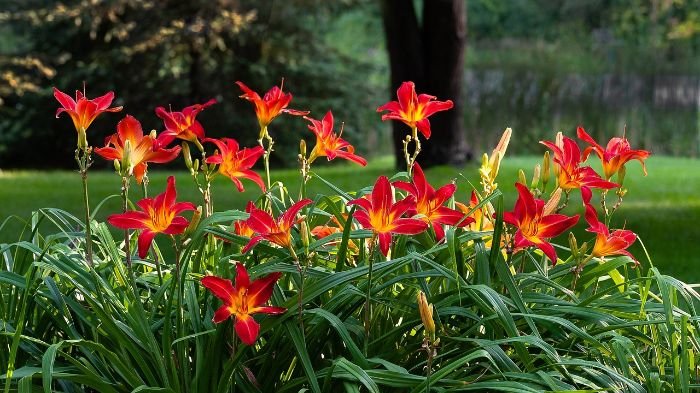
Perennials That Thrive with Minimal Upkeep
Lavender (Lavandula spp.)
Lavender adapts well to dry, sandy, or rocky soils and performs best in full sun. Once established, it tolerates drought and requires no more than one deep watering per week during prolonged dry spells. Annual pruning after flowering maintains shape and encourages new growth. Its aromatic foliage also discourages many insect pests.
Echinacea (Echinacea purpurea)
This North American native is valued for its tolerance to heat, drought, and poor soils. Full sun encourages the highest bloom production, and plants rarely require staking due to their sturdy stems. Removing spent flowers prolongs the bloom period, but even without deadheading, the seed heads feed birds through winter.
Sedum (Hylotelephium spp.)
Sedums excel in low-fertility, well-drained soils where other perennials struggle. Their succulent leaves store water, making them highly drought-resistant. Upright and groundcover forms both maintain neat growth without frequent trimming, and their late-season blooms attract pollinators at a time when other flowers are fading.
Shrubs That Hold Structure Without Intensive Pruning
Boxwood (Buxus spp.)
Boxwood provides evergreen form year-round and responds well to light shaping, though many cultivars maintain a compact habit without frequent clipping. It adapts to a range of soils and light exposures from full sun to partial shade, and modern disease-resistant varieties reduce risk of blight.
Spirea (Spiraea spp.)
Spirea is a reliable flowering shrub that tolerates both urban pollution and a wide range of soils. Minimal pruning after flowering promotes next year’s growth, and its natural form stays tidy without extensive shaping. Drought tolerance improves once established, making it a low-water option for borders.
Juniper (Juniperus spp.)
Junipers offer year-round foliage in a range of forms from groundcovers to tall screens. They thrive in full sun with well-drained soil and require virtually no pruning unless shaping is desired. Natural resistance to most pests and diseases further reduces the need for intervention.
Annuals That Deliver Color Without Demanding Care
Zinnia (Zinnia elegans)
Zinnias bloom heavily in full sun with minimal fertilization and moderate watering. They withstand heat well, and disease-resistant varieties prevent common leaf spot issues. Direct seeding into prepared soil eliminates the need for indoor starting or transplanting.
Marigold (Tagetes spp.)
Marigolds handle a range of soil types and bloom continuously with occasional deadheading. Their natural pest-repelling qualities make them effective companion plants, reducing the need for chemical controls. Regular sun exposure and well-drained soil keep growth steady.
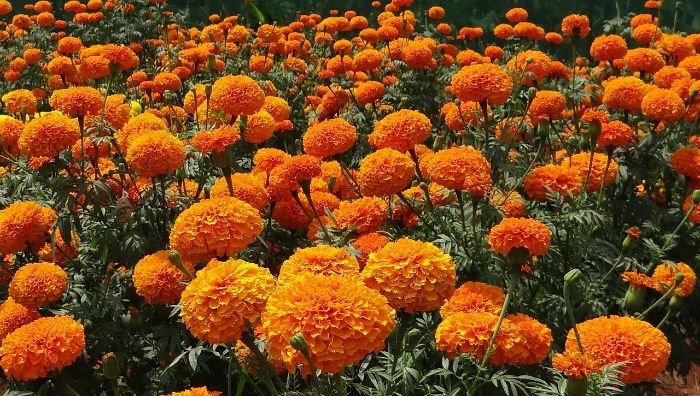
Cosmos (Cosmos bipinnatus)
Cosmos prefers poor to moderately fertile soil and performs best when not overwatered. Its fine, airy foliage rarely suffers pest damage, and plants reseed readily in suitable climates, creating a self-renewing display without replanting every year.
A garden built from well-chosen perennials, shrubs, and annuals can retain its structure and beauty through the seasons with minimal hands-on care. By combining long-lived structural plants with self-sufficient seasonal bloomers, the design remains dynamic yet low-maintenance. The next step is integrating these plant categories into a layout that simplifies watering, limits weed growth, and reduces pruning demands over time.
Designing a Low-Maintenance Garden Layout
A garden that stays attractive with minimal attention is the result of deliberate planning. The goal is to arrange plants so that their environmental needs align, maintenance tasks overlap, and resource use remains efficient. This design approach not only reduces time spent on care but also extends the life and vigor of plantings by minimizing stress.
Structuring Plant Zones for Efficient Care
Dividing the garden into zones based on water, sunlight, and soil requirements prevents mismatched plantings that demand constant adjustments. Plants with similar needs respond consistently to the same care schedule, eliminating the need for individualized watering or fertilization.
| Zone Type | Sun Exposure | Water Needs | Example Plants |
|---|---|---|---|
| Dry, Full Sun | 6+ hours direct sunlight | Once a week deep soak | Lavender, Russian Sage, Sedum |
| Moist, Partial Shade | 3-5 hours filtered sunlight | Twice a week moderate | Hosta, Astilbe, Hydrangea |
| Low Light, Moist Soil | Less than 3 hours sunlight | Keep evenly moist | Ferns, Ligularia, Japanese Forest Grass |
Integrating Pathways and Access Points
Pathways made of gravel, pavers, or compacted mulch reduce soil compaction around plants and allow access without stepping into planting beds. This prevents damage to root systems and keeps maintenance zones clearly defined. Placing access points strategically means every area of the garden is reachable without navigating through dense plantings.
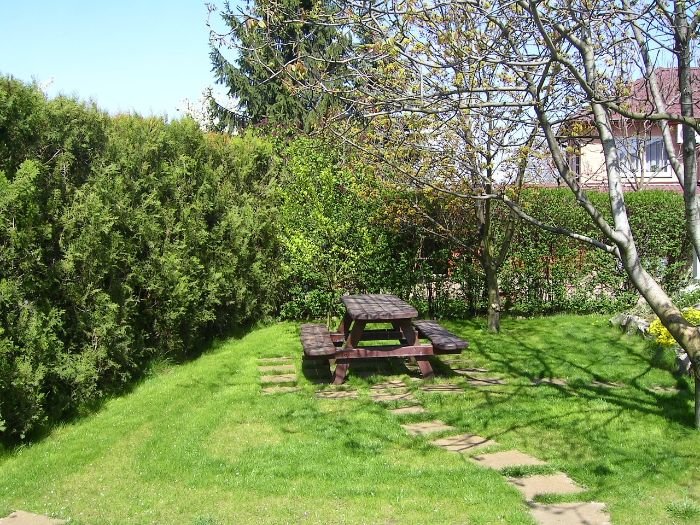
Using Groundcovers to Replace High-Maintenance Lawn Areas
Groundcovers form a living mulch that suppresses weeds, conserves moisture, and eliminates mowing. Species such as creeping thyme, ajuga, or pachysandra adapt well to a variety of conditions and create a continuous, low-growing cover. In large spaces, groundcovers can reduce maintenance hours significantly compared to turf grass.
Planning for Year-Round Structure and Color
Combining evergreen shrubs with perennials that peak in different seasons prevents the garden from looking empty at any time of year. Spring bulbs, summer perennials, autumn foliage plants, and winter-interest evergreens work together to keep visual appeal high while avoiding the need for constant replanting. Proper spacing allows mature plants to fill their allotted area without crowding, reducing the need for frequent thinning.
A well-structured layout limits maintenance by allowing plants to grow into the space intended for them, reducing competition and minimizing intervention. When zones, access points, and year-round structure are designed at the outset, the garden functions efficiently for years with only seasonal adjustments.
Planting and Care Strategies That Save Hours
Early decisions about soil, water delivery, and routine care determine workload for the entire season. Focus on drainage, mulch depth, and right‑sized irrigation. Add a simple care calendar that favors infrequent, deliberate actions over constant tinkering. That combination keeps plants vigorous and reduces emergency fixes.
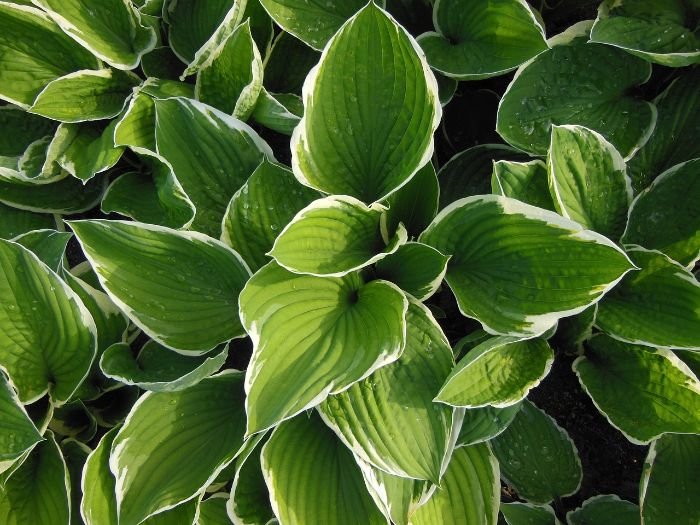
Soil Prep That Prevents Ongoing Problems
Healthy structure in the root zone cuts watering and feeding demands.
Start with a quick drainage check: dig a hole 12 inches deep, fill with water, let it drain, then refill and time the drop. Rates under 0.5 inch per hour call for raised mounds or berms rather than heavy amendments. Rates between 0.5 and 2 inches per hour suit most low‑care species.
Spread a 0.5-1 inch layer of finished compost across beds in early spring. Avoid deep tilling that brings up weed seed and collapses soil aggregates. Set mulch at 2-3 inches (5-7 cm) after planting, keeping a 2-3 inch gap around stems and trunks to prevent rot. Mulch stabilizes soil temperature, suppresses weeds, and slows evaporation, which reduces irrigation frequency.
For clay-leaning sites, favor fibrous‑rooted plants with documented tolerance for slower drainage. For sandy sites, select drought‑adapted plants and add organic top‑dressings each spring to improve water retention without creating a soggy layer.
Drip and Soaker Systems With Practical Settings
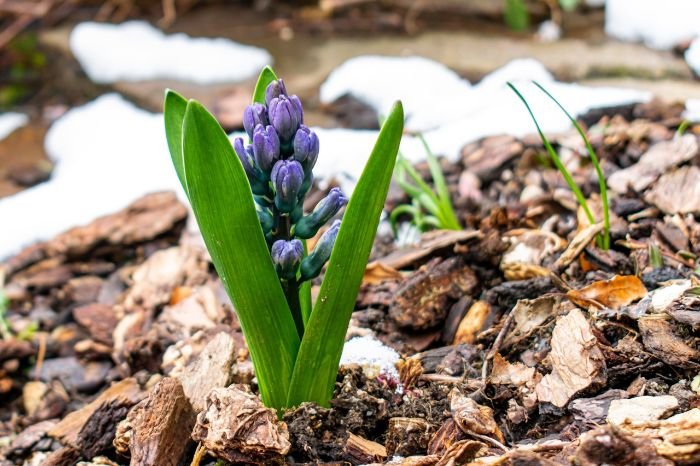
Time saved on irrigation comes from steady low‑flow delivery. Install a pressure regulator set near 20 psi and a filter to protect emitters. Use 0.5-1.0 gallon‑per‑hour emitters for perennials and 1.0-2.0 gallon‑per‑hour emitters for shrubs. Place one emitter near the root ball of small perennials, two emitters for medium shrubs, and a ring of three or four for large shrubs. Lay tubing under mulch to limit evaporation.
Use the table to set starting schedules, then adjust after one week based on soil moisture at 4-6 inches depth.
| Planting Zone | Soil Type | Emitter Rate (gph) | Typical Summer Schedule* | Notes |
|---|---|---|---|---|
| Drought‑tolerant perennials | Sandy/loamy | 0.5-1.0 | 1 long soak weekly | Skip if rain > 0.75 in. |
| Mixed border perennials | Loamy | 0.5-1.0 | 2 shorter soaks weekly | Aim for 0.75-1 in. water total |
| Foundation shrubs | Loamy/clay | 1.0-2.0 | 1 deep soak weekly | Add a second cycle during heat waves |
*Use a timer with “cycle and soak” to reduce runoff – two back‑to‑back cycles deliver better infiltration than one long run. For new plantings, water 2-3 times per week for 6-8 weeks, then shift to the schedule above once roots expand.
Low‑Input Care Calendar for Pruning, Feeding, and Clean‑Up
A simple calendar avoids constant chores. In late winter, cut ornamental grasses to 4-6 inches and remove dead stems from perennials. In early spring, top-dress beds with a 0.5 inch layer of compost rather than frequent fertilizer applications. Slow-release organic granules can supplement poor soils at label rates without pushing weak, leggy growth.
After spring‑flowering shrubs finish, prune lightly to maintain size and daylight to interior branches. Summer-blooming shrubs respond well to shaping in late winter, which concentrates energy into new wood. For flowering perennials, remove entire spent stalks rather than pinching individual blooms to save time. Sanitize pruners with isopropyl alcohol between plants to limit disease spread.
Adopt a “fifteen-minute pass” once per week in peak season. Pull small weeds while soil is slightly moist, check mulch depth, lift any sagging drip lines, and spot problems before they scale up. Short, consistent passes prevent weekend-long catch-up sessions.
A garden run on measured irrigation, stable soil, and a light‑touch calendar will stay orderly without daily attention. With core care dialed in, common issues such as weeds, pests, and heat spikes become quick adjustments rather than full projects.
Solving Common Low‑Maintenance Garden Problems
Pests, weeds, and weather drive most of the work in any garden. Reduce that workload by removing the conditions that invite problems, and by scheduling quick preventive checks. Small, repeatable actions outperform emergency fixes and keep plantings stable through the season.
Pest and Disease Resistance Without Sprays
Strong plants and clean habits stop most outbreaks before they start. I favor early sanitation and habitat for beneficial insects over reactive treatments.
- Space plants to match mature width so air can move through foliage. Poor airflow invites mildew and leaf spot.
- Water at soil level with drip or soaker lines. Wet leaves, especially in the evening, raise disease pressure.
- Sanitize tools with isopropyl alcohol between plants. Pruners spread pathogens when blades carry infected sap.
- Add nectar sources for predators that hunt common pests. Dill, fennel, alyssum, and yarrow support lacewings, hoverflies, and parasitic wasps.
- Choose resistant cultivars where available. Disease‑tolerant monarda, mildew‑resistant phlox, and rust‑resistant hollyhocks lower intervention needs.
Practical thresholds help decide when to act. A few aphids on a vigorous coneflower rarely justify control. Distorted new growth, honeydew, or sooty mold signal action – a firm water spray followed by a check in three days often resets populations without chemicals.
Weed Suppression That Lasts
Weeds steal water and light, then multiply by seed. Win that race by blocking light at the soil surface and by removing seedlings before roots anchor.
- Keep mulch at 2-3 inches across open soil. Replenish thin spots in spring and late summer.
- Edge beds with a clean vertical cut 4-6 inches deep. A defined edge slows lawn creep and makes hand removal faster.
- Plant living mulch where foot traffic is light. Creeping thyme, mazus, or dwarf mondo grass knit into a low mat and deny space to invaders.
- Use the “stale seedbed” approach before planting annuals. Irrigate bare soil for one week, let weed seedlings emerge, then slice them off at the surface. Plant afterwards into a cleaner bed.
- Pull seedlings after rain or irrigation. Roots release cleanly, which saves time and avoids resprouting.
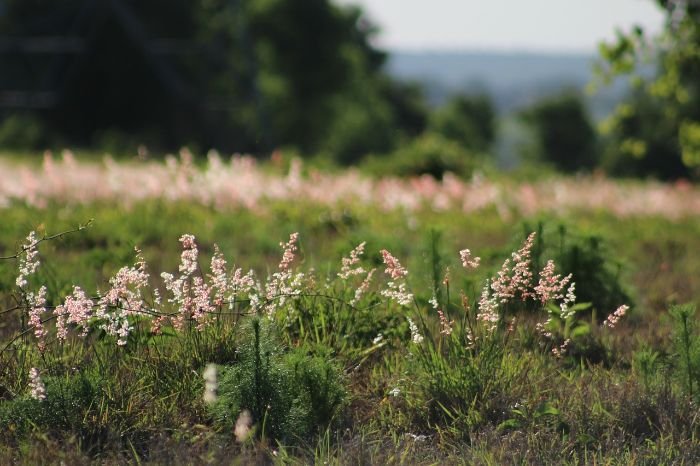
Landscape fabric belongs under gravel paths and seating areas, not in planting beds. Fabric under shrubs traps roots near the surface and complicates future work.
Weather Shielding for Heat, Frost, and Wind
Temperature swings, intense sun, and dry wind create stress that looks like disease but comes from water loss and tissue damage. A few simple tools avoid that spiral.
- Heat waves – add 30-40% shade cloth over frames or stakes for two to three days. Deep‑water in the early morning so roots face midday heat with a full profile.
- Frost events – float a breathable row cover rated to 28-30°F over tender plants before sunset. Secure edges to the ground to trap radiant heat. Remove in the morning once air warms.
- Wind exposure – plant windbreaks using layered structure. Juniper, boxwood, and inkberry slow gusts at ground level and protect perennials behind them.
- Heavy rain – raise beds 6-8 inches where drainage tests show slow infiltration. In low spots, cut a shallow swale to move water to a safe outlet.
- Drought runs – widen drip rings on shrubs as root systems expand. Longer intervals with deeper soaks build roots that handle gaps between irrigations.
Quick Match: Problem – Prevention – Plant Examples
| Problem | Likely Cause | Prevention Action | Low‑Care Plant Examples |
|---|---|---|---|
| Powdery mildew on bee balm | Crowding and humid canopy | Increase spacing, morning irrigation at soil level | Monarda ‘Jacob Cline’, phlox ‘Jeana’ |
| Root rot on lavender | Poor drainage and overwatering | Mound planting, fast‑draining soil, drip only | Lavender ‘Hidcote’, ‘Munstead’ |
| Aphids on new growth | Tender flush without predators | Blast with water, add alyssum for hoverflies | Echinacea, sedum, catmint |
| Deer browsing on shrubs | Unprotected buffet at edge zones | Swap to deer‑resistant species, use double‑row layout | Boxwood, spirea, juniper |
A garden that anticipates pests, weeds, and weather avoids most crises. Preventive spacing, clean irrigation, steady mulch, and quick covers handle the majority of threats with minutes per week.
Conclusion – Lock In Low-Maintenance Results
Low‑maintenance gardening succeeds when plant choice matches sun, soil, and zone. Grouping by water needs, setting drip irrigation, and holding mulch at 2-3 inches cut routine work to short, repeatable passes. Disease‑resistant cultivars, slow growers, and evergreen structure hold form without constant pruning. A short weekly check prevents small issues from scaling into weekend projects.
Measured habits keep the workload predictable. Track sun hours, record infiltration rate, set emitter flow, and log watering frequency. Revisit settings at the change of each season. I keep a fifteen‑minute walk‑through during peak months to lift sagging lines, top up thin mulch, and remove seedlings after rain. That cadence keeps beds clean, roots deep, and foliage healthy.
90‑Day Action Plan
- Weeks 1 and 2 – Map sun exposure by area, run a 12‑inch drainage test, and label zones by water need. Shortlist 15-20 proven plants that match local hardiness zone and soil.
- Week 3 – Top‑dress beds with 0.5-1 inch compost, install a filtered and regulated drip line, and add 2-3 inches of mulch with a clear collar around stems.
- Weeks 4 to 8 – Plant, water deeply to 6-8 inches, and verify soil moisture at 4-6 inches before each irrigation cycle.
- Weeks 9 to 12 – Shift to one weekly deep soak for drought‑tolerant zones and two shorter cycles for mixed borders. Prune spring bloomers after flowering and set stakes for any wind‑exposed spots.
- Ongoing – Hold the fifteen‑minute weekly pass. Replenish mulch in early spring and late summer, widen drip rings as shrubs mature, and note any cultivar that underperforms for replacement in fall.
A garden built on site‑matched plants, zoned layout, and measured care will save hours every month and remain stable through heat, wind, and short dry spells.
FAQ
How often should I water drought‑tolerant plants during summer heat?
After the first 6-8 weeks of establishment, aim for one deep soak per week that delivers roughly 0.75-1 inch of water. Use drip emitters at 0.5-1.0 gph for perennials and 1.0-2.0 gph for shrubs, then adjust by checking soil moisture at 4-6 inches depth the next morning. Add a second cycle during multi‑day heat waves. Subtract any rainfall measured by a simple rain gauge to avoid overwatering.
What mulch depth and material keeps weeds low without stressing plants?
Hold mulch at 2-3 inches across planting beds and keep a 2-3 inch gap around stems and trunks. Shredded bark or arborist wood chips work well for mixed borders and shrubs because they suppress light and moderate soil temperature. Use 1-2 inches of gravel around lavender, sedum, and other xeric plants to protect crowns from excess moisture. Refresh in early spring and late summer where coverage thins.
How do I test drainage and decide if raised beds are necessary?
Dig a hole 12 inches deep, fill with water, let it drain, then refill and time the drop. Rates below 0.5 inch per hour point to poor infiltration, so plant on mounded berms or install raised beds 6-8 inches high. Rates between 0.5 and 2 inches per hour suit most low-care plantings. Faster than 2 inches per hour indicates very quick drainage, so add seasonal compost top‑dressings and favor drought‑adapted species.
Which shrubs keep shape with the least pruning over five years?
Compact cultivars that reach their mature size without heavy shaping cut labor. Boxwood selections such as ‘Green Velvet’, spirea selections such as ‘Goldmound’, and low‑spreading junipers such as ‘Blue Pacific’ maintain tidy form with one light trim per year or less. Space each plant by its stated mature width so branches do not collide, which avoids corrective pruning later.
How can I irrigate mixed sun and shade beds without overwatering cooler areas?
Put sun and shade areas on separate valves, then size run times to exposure. Use pressure‑compensating drip lines so emitters deliver consistent flow on slopes and long runs. In shade beds, reduce duration by 30-40 percent and verify moisture at 4-6 inches before each cycle. A basic seasonal adjustment on the controller trims run times during spring and fall when demand drops.
What are reliable groundcovers that replace lawn with low upkeep?
In full sun, creeping thyme and sedum spurium create dense cover that needs minimal water once established and no mowing. In partial shade, pachysandra, ajuga, and dwarf mondo grass form a stable mat that suppresses weeds and handles light foot traffic. Prepare soil, set plants at close spacing for quick fill‑in, and use edging to prevent encroachment into paths.
How do I keep container plantings low‑maintenance on a hot patio?
Use large, light‑colored containers with drainage holes and a soilless mix that includes pine bark for structure. Add a reservoir insert or a drip line on a timer to automate deep watering. Top the surface with 1 inch of gravel or bark to slow evaporation. Heat‑tolerant choices such as rosemary, lantana, and portulaca hold up with modest water and infrequent feeding.
How do I choose native or regionally adapted plants that genuinely cut maintenance?
Start with your USDA zone and local extension lists, then pick species with documented drought tolerance and disease resistance. Favor plants that match your soil texture and pH to avoid repeated amendments. When options include named cultivars, select those bred for mildew or rust resistance, which reduces interventions and keeps foliage clean through humid stretches.






